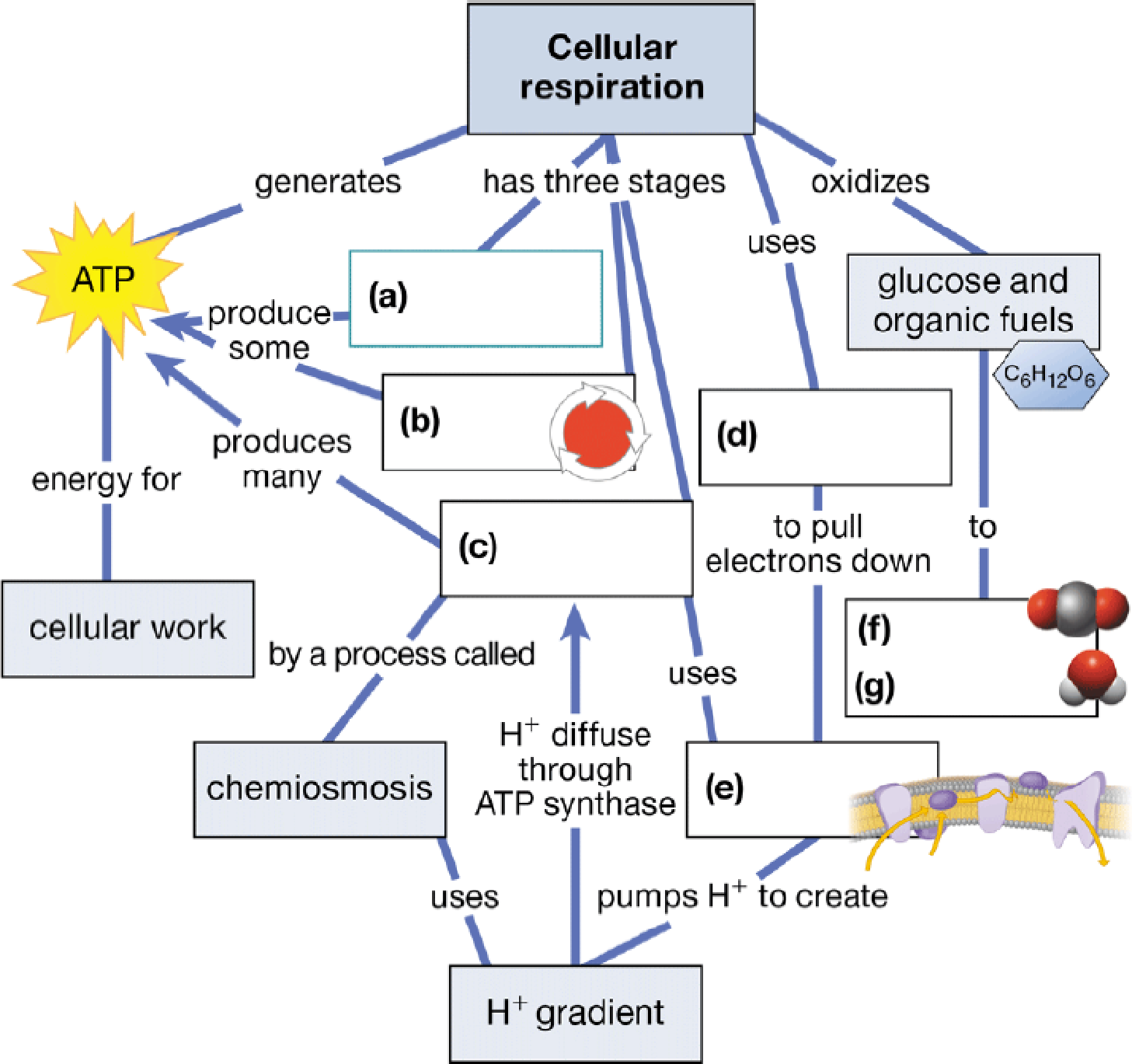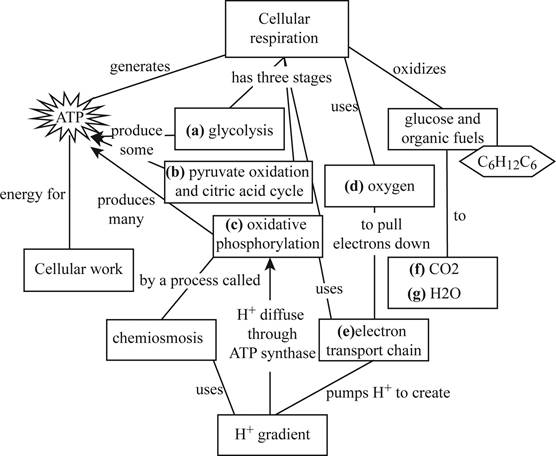
Concept explainers
Fill in the blanks in this summary map to help you review the key concepts of

To complete: The concept map to summarize the key concepts of cellular respiration.
Introduction:
The process of breathing and cellular respiration are closely associated. By breathing, an individual takes oxygen into the lungs and passes it to the blood. The blood carries the oxygen to cells where cellular respiration is carried out. Cellular respiration generates energy that is utilized for various cellular activities. There are several steps in cellular respiration; it includes glycolysis, pyruvate oxidation and citric acid cycle, and oxidative phosphorylation.
Answer to Problem 1CC
Pictorial representation: The Fig. 1 shows the vital concepts in cellular respiration.

Fig.1: Concepts map of cellular respiration.
Explanation of Solution
(a)
Correct answer: Glycolysis
Explanation:
Glycolysis is the first step of cellular respiration which occurs in the cytoplasm of the cell. The glycolysis process results in a breakdown of one glucose molecule into a three-carbon compound called pyruvate.
Hence, the correct answer is glycolysis.
(b)
Correct answer: Pyruvate oxidation and citric acid cycle
Explanation:
Pyruvate oxidation and the citric acid cycle are the second stage of the cellular respiration which takes place in the mitochondria. Here, pyruvate is oxidized into a two-carbon compound called acetyl Co-A. The citric acid cycle then completes the breakdown of glucose to carbon dioxide.
Hence, the correct answer is pyruvate oxidation and citric acid cycle.
(c)
Correct answer: Oxidative phosphorylation
Explanation:
Oxidative phosphorylation is the third stage of the cellular respiration. This involves electron transport and chemiosmosis. Oxidative phosphorylation is responsible for most of the ATP formation during the process of cellular respiration.
Hence, the correct answer is oxidative phosphorylation.
(d)
Correct answer: Oxygen
Explanation: Cellular respiration requires oxygen to trap the electrons in an electron transport chain. This helps in the generation of ATP by oxidative phosphorylation.
Hence, the correct answer is oxygen.
(e)
Correct answer: Electron transport chain
Explanation:
Electron transport chain is a series of an arranged molecular system in the mitochondrial cristae that passes the electrons to generate a proton potential across the inner mitochondrial membrane. This is required for oxidative phosphorylation and chemiosmosis.
Hence, the correct answer is electron transport chain.
(f)
Correct answer: CO2
Explanation:
Cellular respiration oxidizes the glucose and the organic fuels into carbon dioxide (CO2) and water molecules (H2O).
Hence, the correct answer is CO2.
(g)
Correct answer: H2O
Explanation:
Cellular respiration oxidizes the glucose and the organic fuels into carbon dioxide (CO2) and water molecules (H2O).
Hence, the correct answer is H2O.
Want to see more full solutions like this?
Chapter 6 Solutions
CAMPBEL BIOLOGY:CONCEPTS & CONNECTIONS
- See the data and answer this question in your own words. Step by step and explain. In this lab we used CO2 sensor placed in respiration chamber. Do you have evidence that cellular respiration occurred in mung beans? Explain in your own words, do not copy and paste from google.arrow_forwardThe latest article of the Wall Street Journal says “Cellular Respiration is 100% an Exergonic and Anabolic process. Is this statement true or false? Explain why this statement is true or false.arrow_forwardPut the following steps in chronological order based upon what you would do to determine if an organism can perform cellular respirationarrow_forward
- In a simple sentence identify what materials cellular respiration NEEDS and what may materials it makesarrow_forwardIn analyzing all the steps of cellular respiration, which step would you consider the most important and which step the least important. Give reasons to justify the steps you have chosen.arrow_forwardCellular respiration takes place in mitochondria, They are like power houses of cells. They are found in both plant and animal cells. True Falsearrow_forward
- Some people say that plant cells carry out photosynthesis and animal cells carry out respiration. Do you agree or disagree with this statement? Provide a valid explanation to support your answer. [Details Explanation]arrow_forwardBased on what you have learned about metabolic regulation, how might fructose- 1,6-bisphosphate and/or glucose-6-phosphate modulate respiration? Design an experiment to test your idea. Edit View Insert Format Tools Table Paragraph v O wordsarrow_forwardPart 1 Using a Table similar to the one below, compare the process of aerobic respiration with that of anaerobic respiration. You should consider as part of this comparison: Please adjust your table to fit the number of points you are making. Aerobic Respiration Points to Consider The specific pathways (stages) involved The cellular location(s) Oxygen requirements Net ATP yield Any additional points for comparison that Anaerobic Respirationarrow_forward
- Based on your understanding of cellular respiration, explain in detail the main difference between aerobic and anaerobic cellular respiration. Use detail.arrow_forwardDescribe in words what these equations tell us about cellular respiration.arrow_forwardList the 4 stages of cellular respiration and very briefly tell me what happens in each.arrow_forward
 Human Anatomy & Physiology (11th Edition)BiologyISBN:9780134580999Author:Elaine N. Marieb, Katja N. HoehnPublisher:PEARSON
Human Anatomy & Physiology (11th Edition)BiologyISBN:9780134580999Author:Elaine N. Marieb, Katja N. HoehnPublisher:PEARSON Biology 2eBiologyISBN:9781947172517Author:Matthew Douglas, Jung Choi, Mary Ann ClarkPublisher:OpenStax
Biology 2eBiologyISBN:9781947172517Author:Matthew Douglas, Jung Choi, Mary Ann ClarkPublisher:OpenStax Anatomy & PhysiologyBiologyISBN:9781259398629Author:McKinley, Michael P., O'loughlin, Valerie Dean, Bidle, Theresa StouterPublisher:Mcgraw Hill Education,
Anatomy & PhysiologyBiologyISBN:9781259398629Author:McKinley, Michael P., O'loughlin, Valerie Dean, Bidle, Theresa StouterPublisher:Mcgraw Hill Education, Molecular Biology of the Cell (Sixth Edition)BiologyISBN:9780815344322Author:Bruce Alberts, Alexander D. Johnson, Julian Lewis, David Morgan, Martin Raff, Keith Roberts, Peter WalterPublisher:W. W. Norton & Company
Molecular Biology of the Cell (Sixth Edition)BiologyISBN:9780815344322Author:Bruce Alberts, Alexander D. Johnson, Julian Lewis, David Morgan, Martin Raff, Keith Roberts, Peter WalterPublisher:W. W. Norton & Company Laboratory Manual For Human Anatomy & PhysiologyBiologyISBN:9781260159363Author:Martin, Terry R., Prentice-craver, CynthiaPublisher:McGraw-Hill Publishing Co.
Laboratory Manual For Human Anatomy & PhysiologyBiologyISBN:9781260159363Author:Martin, Terry R., Prentice-craver, CynthiaPublisher:McGraw-Hill Publishing Co. Inquiry Into Life (16th Edition)BiologyISBN:9781260231700Author:Sylvia S. Mader, Michael WindelspechtPublisher:McGraw Hill Education
Inquiry Into Life (16th Edition)BiologyISBN:9781260231700Author:Sylvia S. Mader, Michael WindelspechtPublisher:McGraw Hill Education





